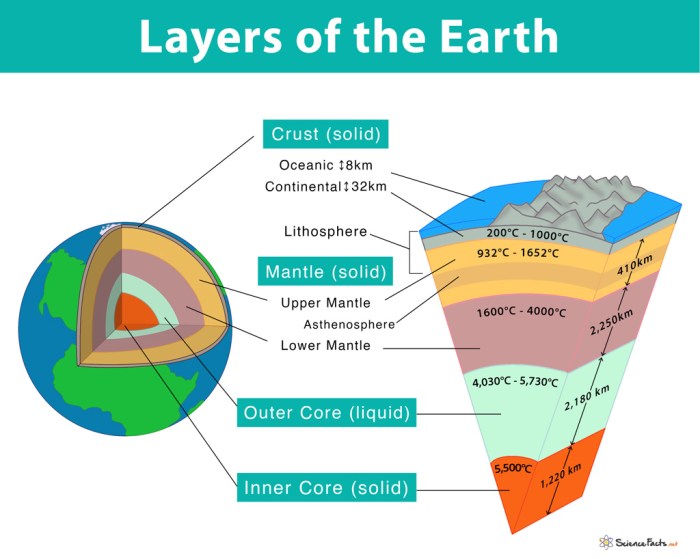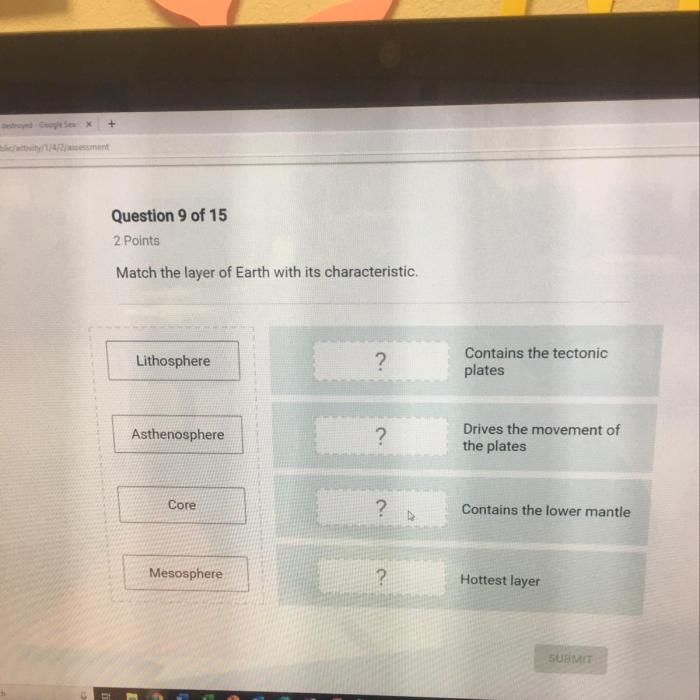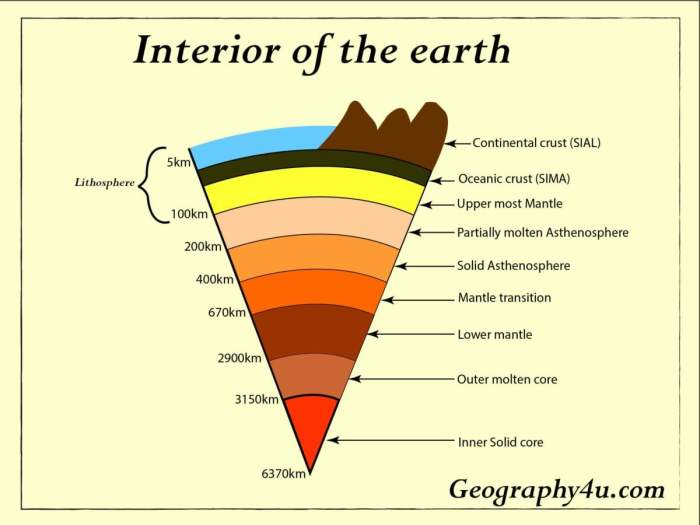Match the layer of earth with its characteristic – Matching Earth’s Layers with Their Unique Characteristics embarks on an intriguing journey, inviting readers to delve into a realm of scientific discovery. This discourse promises a comprehensive exploration of Earth’s intricate structure, uncovering the distinct traits of each layer, from the outermost crust to the enigmatic inner core.
As we traverse through the Earth’s mantle, we will encounter a dynamic realm of molten rock, while the outer core’s liquid iron core sets the stage for Earth’s magnetic field. Finally, we venture into the enigmatic inner core, where extreme temperatures and pressures reign supreme.
1. Crust

The crust is the outermost layer of the Earth and is relatively thin, ranging in thickness from 5 to 70 kilometers (3 to 43 miles). It is composed primarily of igneous, sedimentary, and metamorphic rocks.
Composition of the Crust
The crust is composed of a variety of elements, including oxygen, silicon, aluminum, iron, calcium, sodium, potassium, and magnesium. The most common minerals in the crust are quartz, feldspar, and mica.
Types of Crust
There are two main types of crust: continental crust and oceanic crust. Continental crust is thicker and less dense than oceanic crust and is composed primarily of granite and other felsic rocks. Oceanic crust is thinner and denser than continental crust and is composed primarily of basalt and other mafic rocks.
Examples of Rocks Found in the Crust
- Granite
- Basalt
- Sandstone
- Limestone
- Marble
2. Mantle

The mantle is the layer of the Earth that lies beneath the crust and extends to a depth of about 2,900 kilometers (1,800 miles). It is composed primarily of silicate rocks, such as peridotite and dunite.
Composition of the Mantle
The mantle is composed primarily of the elements oxygen, silicon, magnesium, and iron. It is also composed of a variety of other elements, including aluminum, calcium, sodium, and potassium.
Physical Properties of the Mantle
The mantle is solid, but it is not as rigid as the crust. It is able to flow slowly over long periods of time. The temperature of the mantle increases with depth, and it is about 3,700 degrees Celsius (6,700 degrees Fahrenheit) at the boundary between the mantle and the core.
Convection Currents in the Mantle
The heat from the Earth’s core causes convection currents in the mantle. These currents are responsible for the movement of the tectonic plates on the surface of the Earth.
3. Outer Core
The outer core is the layer of the Earth that lies beneath the mantle and extends to a depth of about 5,150 kilometers (3,200 miles). It is composed primarily of iron and nickel.
Composition of the Outer Core
The outer core is composed primarily of iron and nickel. It also contains a small amount of other elements, such as sulfur, oxygen, and silicon.
Physical Properties of the Outer Core, Match the layer of earth with its characteristic
The outer core is liquid. The temperature of the outer core is about 4,400 degrees Celsius (8,000 degrees Fahrenheit).
Movement of the Outer Core
The outer core is rotating faster than the rest of the Earth. This rotation is responsible for the Earth’s magnetic field.
4. Inner Core

The inner core is the innermost layer of the Earth and extends to a depth of about 1,220 kilometers (760 miles). It is composed primarily of iron and nickel.
Composition of the Inner Core
The inner core is composed primarily of iron and nickel. It also contains a small amount of other elements, such as sulfur, oxygen, and silicon.
Physical Properties of the Inner Core
The inner core is solid. The temperature of the inner core is about 5,200 degrees Celsius (9,400 degrees Fahrenheit).
Extreme Conditions within the Inner Core
The inner core is subjected to extreme pressure and temperature. The pressure at the center of the inner core is about 3.6 million atmospheres (3.6 million times the pressure at sea level) and the temperature is about 5,200 degrees Celsius (9,400 degrees Fahrenheit).
Top FAQs: Match The Layer Of Earth With Its Characteristic
What is the composition of the Earth’s crust?
The crust is primarily composed of igneous, sedimentary, and metamorphic rocks.
What are the physical properties of the mantle?
The mantle is characterized by its high temperature and pressure, resulting in a solid but deformable state known as “plastic.”
How does the outer core contribute to Earth’s magnetic field?
The outer core’s movement generates electric currents, which in turn create Earth’s magnetic field.